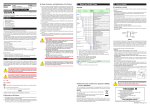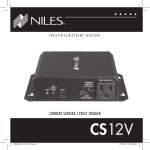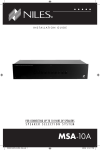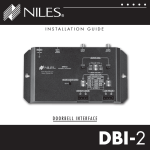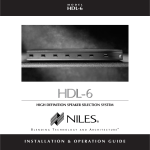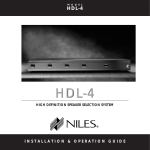Download Niles Audio IPC-6 Stereo System User Manual
Transcript
M O D E L IPC-6 IPC-6 INTELLIGENT POWER CONTROLLER PROGRAM POWER A-TRIGGER-B ON OFF SELECT TIME 1 2 3 4 5 6 C1 C2 NILES IPC-6 INTELLIGENT POWER CONTROLLER NILES ® Niles Audio Corporation NILES www.nilesaudio.com 12331 S.W. 130 Street Miami, Florida 33186 Tel: (305) 238-4373 Fax: (305) 238-0185 ©1999 Niles Audio Corporation. All rights reserved. Niles and the Niles logo are registered trademarks of Niles Audio Corporation. All other trademarks are the properties of their respective owners. Because we continually strive to improve our products, Niles reserves the right to change product specifications without notice. The technical and other information contained herein is not intended to set forth all technical and other specifications of Niles products. Additional information can be obtained on-line at www.nilesaudio.com or by calling Niles at 1-800-289-4434. Printed in USA 5/99 LT00089D. ® I N S TA L L AT I O N & O P E R AT I O N G U I D E I N T E L L I G E N T P O W E R C O N T R O L L E R I N T E L L I G E N T P O W E R C O N T R O L L E R IPC-6* Intelligent Power Controller TABLE OF CONTENTS Introduction 1 Features and Benefits 3 Installation Considerations 5 Installation 6 Programming 12 Troubleshooting Introduction The IPC-6 is a sophisticated intelligent power controller. It is capable of complete power on/off management in the most complicated Audio or Home Theater Systems. When a component that is plugged into one of its two current sensing outlets is turned on, the IPC-6 activates other outlets and relays based upon a user pre-programmed sequence. Two separate current-sensing outlets provide 2 individual triggering sequences. Conversely, when the "triggering" component is turned off, the IPC-6 initiates a separate user pre-programmed power off sequence. You may also choose to trigger one or both of the sequences by using the unit's 12 volt DC smart-sensing trigger inputs. Specifications 18 Components connected to the IPC-6's switched AC power outlets must be of the "latching" type, that is, they must stay in the "on" state when you remove AC power (unplug it) so that they are "on" when you reapply power (plug it in again). NILES ® Additionally, the IPC-6 is able to control 2 devices or components which need a 12 volt DC signal to turn on (e.g., video projectors and electric screens). Finally, the IPC-6 can control 2 devices that require a switch or relay contact closure for operation (e.g., electric curtains and blinds or low voltage lighting). 1 18 *Patents applied for. Unlike other “current-sensing” power controllers, the Niles IPC-6 uses "smart" current-sensing outlets. The IPC-6 is able to automatically sense as little as a 2 watt difference between a component's "on" and "standby" state. The IPC-6 does not require the triggering component to have a 10, 20, or 30 percent difference between its "on" and "standby" states. You can add to the capabilities of the IPC-6 by using it in combination with other Niles products. Niles makes a series of devices which can be controlled by an IPC-6 including speaker switchers, line-level audio switchers, RF switchers, and composite video switchers. TECH SUPPORT HOTLINE If you have questions regarding the operation of the Niles IPC-6, contact your local Niles dealer or Niles Customer Service at 1-800-289-4434. 2 I N T E L L I G E N T P O W E R C I O N T R O L L E R N T E L L I G E N T P O W E R C O N T R O L L E R TOOLS REQUIRED • 1/8" Standard Slotted Screwdriver • Wire Stripper 3 Features and Benefits The IPC-6 offers unique technology never before available. ● Advanced microprocessor design allows unparalleled flexibility and control. ● The IPC-6 AccusenseTM circuitry automatically “locks on” to tiny differences in power consumption between a component’s “on” and “standby” states. ● The IPC-6 PowertrackerTM circuitry will track those tiny differences even under varying line voltage conditions. ● The IPC-6 AccusenseTM circuitry will work with all types of power supplies including switching types. ● Advanced arc suppression techniques prevent power relay contact arcing, ensuring long relay life. ● After a power failure, the IPC-6 will wait for you to again turn on the system. It does not blindly activate whatever was happening before the power failure. ● The IPC-6 remembers which components you want turned on in two different situations. One situation is triggered by device “A”, the other situation is triggered by device “B”. ● You can trigger either the “A” or the “B” sequences with a 12 volt DC signal applied to the 12 volt sensing inputs. ● The IPC-6 can remember different delay times for each of its switched outlets and control relays. ● Total delay time is adjustable from 0 to 99 seconds. ● Separate "on" and "off" delay times and sequences can be programmed into the IPC-6. ● The IPC-6's 12 volt DC outputs can operate many of the Niles automated switchers. ● The IPC-6 has 2 sets of normally open and normally closed low voltage relay contacts controllable by either or both sequences. ● Printed circuit board design assures high reliability. ● Ideal for home theater, multiroom audio, home automation, boardrooms, museum exhibits, and commercial installations of all types. ● Limited two year parts and labor warranty. ● Proudly made in the USA. 4 I N T E L L I G E N T P O W E R C O N T R O L L E R Installation Considerations IMPORTANT Do not exceed 1500 watts of total power consumption for the devices plugged into each IPC-6. IMPORTANT Do not connect 120 volt AC power to the C1 and C2 terminals, they are low voltage only! Do not connect any signal higher than 30 volts to the trigger inputs! 5 N T E L L I G E N T P O W E R C O N T R O L L E R with a switched AC outlet on the IPC-6. Installation IPC-6 Total Power Capacity Check that the total power consumption of all the devices plugged into the IPC-6 does not exceed 1500 watts. If the total power is greater than 1500 watts, you will need to trigger a Niles AC-3 voltage controlled power strip from one of the IPC-6's 12 volt control outputs. Since the maximum power output of most home outlets is 1500 watts, you'll need to plug the AC-3 into a wall outlet that is on a different circuit breaker than the IPC-6. IPC-6 Low Voltage Contacts (C1 & C2 Controlled Outputs) The IPC-6 has both normally-open and normally-closed contacts to control devices that need a switch to control them. These are low voltage contacts only. DO NOT connect 120 volts AC to these contacts. 12 Volt Trigger Inputs IMPORTANT I The IPC-6's external trigger inputs accept 3-30 volts AC or DC. Switched 120 Volt AC Outlets Test each component to determine whether it has the “latching" type of power control. Start by turning the component on. Next, unplug its AC power cord. Wait 5 minutes, then plug it back in. If the component returns to its fully “on” state rather than to a “standby” state it is suitable for use 1. Select a convenient location for the IPC-6. 2. Run all the necessary wiring to the IPC-6’s planned location. Label the wires with both their origin (which component they power) and their destinati on (which of the switched outl ets that component wi ll use). Use the Programming Worksheet on Page 17 to write down your choices. You will need a convenient written record when you program your IPC-6. 3. Make the low voltage connections to the IPC-6. If you are using any of the low-voltage inputs or outputs, you should remove the IPC-6’s connectors. It is easier to attach the wire to the connector first, before putting the IPC-6 in place. To remove a connector grasp it from the top and bottom with your thumb and forefinger and simply pull straight back. Strip 3/8” of insulation from the end of each wire. Tightly twist the stripped wire to eliminate any frayed ends. Insert each wire into the appropriate hole in the connector block and tighten the terminal with an 1/8” slotted screwdriver. Be certain that the positive terminal on the IPC-6 is connected to the positive terminal of a 12 volt device (see Figure 1). 4. Put the IPC-6 into position and make the connections to it. While carefully observing each label, plug each low voltage connector, switched outlet plug, and triggering component into its respective place (see Figure 2 on page 11). Figure 1 Connecting the Low Voltage Wires 6 I N T E L L I G E N T P O W E R C I O N T R O L L E R N T E L L I G E N T P O W E R C O N T R O L L E R Press the PROGRAM and the SELECT buttons at the same time to enter the PS program mode. The SELECT button steps you through programming each outlet's amount of delay—first for turning on (the on light is lit), then for turning off (the off light is lit). PROGRAM LED Indicates the IPC-6 is in one of the program modes. ON AND OFF LEDS POWER LED Indicates the IPC-6 has power. DIGITAL DISPLAY Shows you the currently selected delay. SELECT BUTTON IPC-6 INTELLIGENT POWER CONTROLLER PROGRAM POWER A-TRIGGER-B ON SELECT 1 OFF 2 3 4 5 6 C1 C2 03 TIME NILES PROGRAM BUTTON Begins and ends all programming. 7 TRIGGER BUTTONS "A" AND "B" OUTLET CONTROL LEDS Normally, these indicate whether the outlet is on or activated. However, if you are in the PS program mode these indicate which outlet is being programming. TIME BUTTONS Allow you to adjust the delay between 0 and 99 seconds. 8 I P N T E L L I G E N T O W E R C I O N T R O L L E R N T E L L I G E N T P O W E R C O N T R O L L E R ACCUSENSETM 120 VOLT AC POWER OUTLETS Turning on the device plugged into one of these outlets will trigger the corresponding (A or B) ON sequence. Turning off the device plugged into one of these outlets will trigger the corresponding (A or B) OFF sequence. POWER CORD Plugs directly into the wall AC outlet. CONTROLLED 12 VOLT DC OUTPUTS Positive = Terminal 1 Ground = Terminal 2 TRIGGER INPUTS CONTROL OUTPUTS C2 C1 CONTROL OUTPUT RELAYS C1 and C2 rated at 5 Amps, 30 Volts Max., AC or DC. C N O N O M C 12V 0.1 AMP + - C N O N O M C 12V 0.1 AMP + - CURRENT SENSE OUTLETS 120 Volts AC 60 Hz. 1500 Watts Max. NILES RELAY DC OUT CONTACT GROUP ONE RELAY DC OUT CONTACT GROUP TWO A B A SENSING 3-30V AC or DC INPUTS Contact groups provide you with a NORMALLY OPEN (N.O.) contact that closes, or a NORMALLY CLOSED (N.C.) contact that opens when C1 or C2 are activated. N.O. = Terminal 1, COMMON = Terminal 2, N.C. = Terminal 3 9 SWITCHED OUTLETS 3-30V 3-30V AC/DC AC/DC + + - B 1 2 3 4 5 6 Niles Audio Corporation, Inc. Miami, Florida USA SWITCHED 120 VOLT AC POWER OUTLETS These turn on and off according to the way you have programmed your IPC-6. REMEMBER: THE TOTAL POWER CONSUMPTION OF ALL DEVICES PLUGGED INTO THE IPC-6 MAY NOT EXCEED 1500 WATTS. 10 I N T E L L I G E N T P C O W E R I O N T R O L L E R 5. Plug the IPC-6's AC power plug into an unswitched AC power outlet. All the lights on the front panel will light for 2 seconds while the IPC-6’s microprocessor checks all conditions. If everything is ok, all but the red POWER LED will turn off. You are now ready to program your IPC-6. Surround Sound Processor Pre-amp Figure 2 Wiring Diagram N T E L L I G E N T P O W E R C O N T R O L L E R Programming You must program your IPC-6 in two steps. 1. The IPC-6’s AccusenseTM circuitry needs to measure the “on” and the “standby” states of the device you have connected to the sensing 120 volt AC outlet(s). 2. The IPC-6 also needs you to specify which outlets to activate along with their corresponding time delays. Measuring Power “On” and “Standby” States. CONTROL OUTPUTS TRIGGER INPUTS C2 C1 CONTROL OUTPUT RELAYS C1 and C2 rated at 5 Amps, 30 Volts Max., AC or DC. C N O N O M C 12V 0.1 AMP + - C N O N O M C 12V 0.1 AMP + - RELAY DC OUT RELAY DC OUT CURRENT SENSE OUTLETS 120 Volts AC 60 Hz. 1500 Watts Max. NILES A B A B Screen Blind Controller 1 2 3 4 Equalizer 5 6 Niles Audio Corporation, Inc. Miami, Florida USA Center Amp Lighting Controller Some devices (television sets, stereo receivers, etc) actually have 3 power states. You can turn them on with a remote control, you can place them in “standby” with a remote control, and you can use a manual power (or “vacation”) switch to turn them completely off. You want the IPC-6 to measure what happens to your device when you use the remote control. Unless you are sure there is not a third power state, use the remote control to turn the device on and off. 1. Turn off the device(s) plugged into the “A” or "B" sensing 120 volt AC outlets. 2. In order to enter the “PA” programming mode, press and hold down the PROGRAM button on the front panel of the IPC-6. While you are holding it down, press the “A” Trigger button, then release both buttons. Projector 11 SWITCHED OUTLETS 3-30V 3-30V AC/DC AC/DC + + - Main Amp Surround Amp The front panel LED's will sequence to the left and right while the AccusenseTM circuitry measures your device's stand12 I N T E L L I G E N T P O W E R C O N T R O L L E R by current. After the sequencing stops, the ON LED should be blinking. This means that the IPC-6 is ready to measure the device’s “on” state. 3. Turn on the device. The front panel LED's will sequence to the left and right while the AccusenseTM circuitry measures your device. After the sequencing of the LED's stops the OFF LED will blink. 4. Turn off the device. The front panel LED's will sequence to the left and right while the AccusenseTM circuitry checks your device. After the sequencing of the LED's stops and the IPC-6 has confirmed the programming, all the front panel LED’s will light while the IPC-6 stores the program into memory. You are now back in normal operating mode. To program the device plugged into the ”B” sensing outlet, repeat steps 1 through 4 using the “B” button and outlet. When you begin programming, the IPC-6 will display “Pb” instead of “PA”. Programming Switched 120 volt and Controlled (low voltage) Outlets You will need to program 3 different parameters for each of the switched outlets (1-6) and control outputs (C1, C2). 1. Which trigger (A, B, or both) will activate the outlet? Pressing both trigger buttons means that the outlet will be active if either or both triggers are active. 2. The turn on time delay (indicated by the ON LED being lit). 13 I N T E L L I G E N T P O W E R C O N T R O L L E R Program the delays for each outlet to build your "turn on" sequence. Delays are calculated in 1 second increments after your triggering device is turned "on" or "off". Therefore, if you would like outlet 1 to activate 2 seconds after your trigger device is turned on, program outlet 1's time delay to 02. If you would like outlet 2 to activate 2 seconds after outlet 1, program outlet 2's time delay to 04, etc. 3. The turn off time delay (indicated by the OFF LED being lit). Program the delays for each outlet to build your "turn off" sequence. Enter the PS programming mode Turn off the devices plugged into the 2 sensing outlets before programming any of the switched or controlled outlets or the IPC-6 will not enter PS programming mode. "TECH TIP" Devices must be turned off before programming any of the outlets. Press and hold down the PROGRAM button on the front panel of the IPC-6. While you are holding it down, press the SELECT button. Release both buttons. When you begin programming the IPC-6 will display "PS" only momentarily. The IPC-6 will light the ON and "Outlet 1" LED's. You are now ready to program the "turn on" sequence for each switched outlet. 1. Select either or both of the trigger buttons (A, B). This will determine which device(s) will trigger outlet 1 to turn on. 2. Adjust the "on" time delay. The two buttons to the right of 14 I N T E L L I G E N T P O W E R C O N T R O L L E R the display allow you to adjust the delay from 0 to 99 seconds. 3. Press the SELECT button to lock in your programming and move to the next outlet. Repeat steps 1-3 for outlets 2 through 6 and C1, C2. Pressing the SELECT button after you have programmed C2 enables you to program the "off" time delays. If you elect not to program one or more of the outlets, you will still need to press SELECT until you have gone past C2 to program the "off" times. The IPC-6 will now light the OFF and "Outlet 1" LED's. 4. Adjust the "off" time delay. There is no need to select a trigger. After you have programmed your "off" time for Outlet 1, use the SELECT button to step through outlets 2-6 and C1, C2. Adjust the "off" time delay of each. 5. Pressing the SELECT button after you have programmed C2 will cycle you back to programming the "on" time delays. 6. Press the PROGRAM button and release it. All the front panel LED's will light for 2 seconds. You have completed programming your IPC-6. I N T E L L I G E N T P O W E R C O N T R O L L E R grammed, return to the programming section of this manual and verify that the IPC-6 has been programmed correctly or simply reprogram the IPC-6. Errors - The display reads E1 The IPC-6 detected a contradictory reading. Check your connections to the sensing 120 volt AC outlets. Perhaps “A” and “B” have been reversed or are actually plugged into another outlet. Press the PROGRAM button to turn off the display of E1, then begin again at step one. Make sure you are "on" and "off" when the directions say you should be. Cancel Programming At any time, you may stop programming by simply pressing and holding the PROGRAM button for one second. Test Test that you have programmed your IPC-6 properly by turning on the components plugged into the "A" trigger outlet. The IPC-6 should now activate your other components according to the sequence you have programmed. Repeat this test with the component plugged into the "B" sensing outlet. If the IPC-6 fails to initiate the sequence you have pro15 16 I N T E L L I G E N T P O W E R C I O N T R O L L E R N T E L L I G E N T P O W E R C O N T R O L L E R IPC-6 PROGRAMMING WORKSHEET Sense A Outlet Controlled Outlet AC Power #1 AC Power #2 AC Power #3 AC Power #4 AC Power #5 AC Power #6 Troubleshooting Sense B Outlet Device you are controlling Trigger Trigger A B You have not completed "on" programming for each controlled outlet. Go to page 12 and follow the step-bystep instructions. 2. You are in the middle of programming your IPC-6 and you see a display of E1. ● Press and hold the PROGRAM button for one second. This returns you to normal operating mode. Now, repeat the programming you last attempted. 3. The wrong devices are turning on with the trigger device. Opening Contact Closing Contact ● Check which sensing outlet the trigger device is plugged into and recheck your programming. ● Check the outlet's programmed trigger source. Power Requirements 120 Volts AC, 1500 Watts max. High Voltage Outlets 2 - Current sensing unswitched 120V AC outlets 6 - Controlled 120V AC outlets Low Voltage Inputs 2 - 3-30V AC/DC control inputs Low Voltage Outputs 2 - 12V DC, 0.1A control outputs 2 - 30V AC/DC, 5A control output relays Overall Dimensions 17" wide x 2" high x 8-1/4" deep 12 Volt Output C2 OFF Delay ● 12 Volt Output C1 ON Delay 1. You turn on the device plugged into Trigger "A" or "B" and nothing happens. SPECIFICATIONS Opening Contact Weight 6-1/4 lbs. Closing Contact ✓ the A, B, or A and B trigger for each device. Write in the time delay for each device. 17 18










